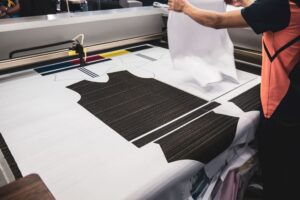From fashion runways to DIY projects, color has always played a powerful role in textile design. At the heart of it lies the art and science of fabric dyeing—a process that transforms plain fabrics into expressive, vibrant works of art. While some techniques are centuries old and rooted in cultural tradition, others are modern adaptations that offer exciting creative freedom.
In this beginner-friendly guide, we’ll explore a range of popular textile dyeing methods, including tie-dye, Shibori, and Ombré, along with insights into the fabric dyeing process. Whether you’re designing for a brand or experimenting with custom apparel, understanding these techniques can open up new possibilities for material storytelling and product innovation.
What Is the Fabric Dyeing Process?
The fabric dyeing process refers to the controlled application of color to textiles in a way that is both purposeful and enduring. Either through traditional or modern methods, each stage of the process plays a crucial role in ensuring even, vibrant, and long-lasting results, especially when working with different fiber types.
The standard stages of the fabric dyeing process include:
- Pre-treatment: Preparing fabric through washing or mordanting to improve dye adhesion and color penetration.
- Dye application: Color is introduced by hand or machine, depending on the chosen method and production scale.
- Fixing and setting: Heat, steam, or chemicals are used to lock in color and prevent premature fading.
- Post-treatment: Final rinsing removes excess dye and helps restore softness to the fabric.
Traditional & Contemporary Textile Dyeing Methods
Today’s designers have access to a wide variety of textile dyeing methods, ranging from ancient craft to high-efficiency modern techniques. Below are a few popular methods used in fashion and custom manufacturing:
Tie-Dye
Tie-dye is a resist-dyeing technique where fabric is twisted, folded, or bound before being dipped into dye. The areas that are tightly tied resist the dye, creating vibrant, swirling patterns that are often associated with 1960s counterculture but have since made a comeback in high fashion and loungewear collections.
Shibori
Originating from Japan, Shibori is a more structured and intricate resist-dyeing method that involves folding, stitching, twisting, or compressing cloth to produce geometric and symmetrical patterns. It’s considered one of the oldest textile dyeing arts and is often used with indigo dye on natural fabrics like cotton or silk.
Ombré
Ombré involves a gradual blending of one color into another, often fading from dark to light. Unlike resist techniques, Ombré requires careful immersion or brushwork to create seamless transitions in color. It’s popular in both apparel and home textiles due to its soft, gradient aesthetic.
Dip Dye
Similar to Ombré but typically more abrupt in color change, dip dyeing involves submerging fabric partially in a dye bath. This simple technique is often used for modern, minimalist looks and is a favorite among DIY creatives.
Ice Dyeing
In ice dyeing, ice is placed on fabric, and powdered dye is sprinkled over it. As the ice melts, it slowly disperses the dye across the fabric and creates unpredictable, watercolor-like effects. It’s experimental, fun, and perfect for making one-of-a-kind designs.
Key Factors to Consider in Fabric Dyeing
When selecting a fabric dyeing technique, weigh both technical requirements and creative goals. These choices influence not only the look of the final product but also its quality, durability, and environmental impact.
Fabric Type Compatibility
Natural fibers like cotton, silk, or hemp tend to absorb dye more effectively than synthetics. Choosing the right fabric can mean better results and stronger color retention over time.
Colorfastness and Durability
Some dyes hold up better than others when exposed to washing, sunlight, or friction. Factor in the product’s intended use to determine which textile dyeing methods will perform best.
Production Scale and Efficiency
Small-batch techniques like Shibori are perfect for limited collections, while methods like vat or reactive dyeing are better suited for industrial-scale production workflows.
Environmental Impact and Dye Type
Opt for plant-based, low-impact, or non-toxic dyes to help minimize environmental harm. Water use, waste, and chemical runoff should all be considered when selecting a textile dyeing method.
Design Intent and Aesthetic Goals
Each dyeing method creates a unique visual outcome—whether that’s sharp contrast, soft gradients, or intricate patterning. Aligning your process with your creative direction is key.
Evolving with the Industry: Modern Approaches to Dyeing
As the fashion industry advances, textile dyeing techniques are evolving to meet new demands in sustainability, efficiency, and creative expression. Many brands are adopting modern innovations that enhance both quality and responsibility.
Here are some key developments driving the future of fabric dyeing:
- Digital and sublimation printing allow for precision coloring, minimal waste, and high customization, especially on synthetic fabrics.
- Low-water dyeing systems reduce environmental impact while maintaining rich color saturation in large-scale production.
- Natural dye revival reintroduces plant-based pigments into commercial use, blending tradition with eco-conscious values.
- Automated dyeing workflows speed up processes, improve color consistency, and minimize human error in production.
- Recycled fabric integration involves dyeing second-life materials like recycled polyester using adjusted techniques that preserve both sustainability and performance.
Bring Your Designs to Life Through Textile Dyeing
Knowing the wide spectrum of fabric dyeing techniques allows designers and developers to unlock a deeper level of creative expression. You might be drawn to the handcrafted charm of tie-dye or the smooth gradients of Ombré. Either way, there’s a world of opportunity in learning how color interacts with fabric.
That’s where Hammax comes in—with thoughtful product development, manufacturing expertise, and a collaborative approach tailored to your brand’s needs. Our end-to-end support helps fashion brands—from startups to established labels—navigate material selection, production processes, and creative innovation. Whether you’re experimenting with textile dyeing methods or building a new collection, we’re here to support your journey from concept to final product.



